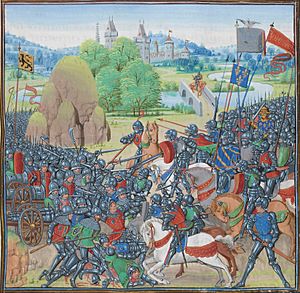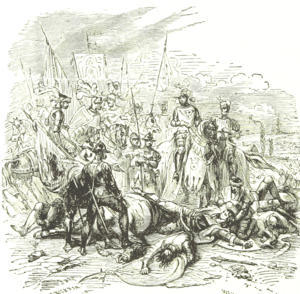Battle of Roosebeke facts for kids
Quick facts for kids Battle of Roosebeke |
|||||||
|---|---|---|---|---|---|---|---|
| Part of the Ghent Rebellion (1379-1385) and the Hundred Years' War | |||||||
 Battle of Roosebeke (Jean Froissart, 1405) |
|||||||
|
|||||||
| Belligerents | |||||||
| Kingdom of France Duchy of Burgundy County of Flanders |
Flemish towns led by Ghent | ||||||
| Commanders and leaders | |||||||
| Charles VI of France Philip the Bold, Duke of Burgundy Olivier de Clisson Louis de Sancerre Mouton de Blainville |
Philip van Artevelde † | ||||||
| Strength | |||||||
|
10,000
|
30,000–40,000 | ||||||
| Casualties and losses | |||||||
| 100 killed | 27,500 killed | ||||||
The Battle of Roosebeke was an important fight in the Hundred Years' War. It happened on November 27, 1382. This battle was fought between a Flemish army and a French army. The Flemish army was led by Philip van Artevelde. The French army was led by Louis II of Flanders, who got help from the French king Charles VI. The battle took place near a hill called Goudberg, in a place now known as Westrozebeke. The Flemish army lost, and Philip van Artevelde was killed.
Contents
Why the Battle Happened
The Battle of Roosebeke was part of a bigger conflict. This conflict involved the Flanders region and the French king. Philip the Bold was a powerful duke. He was also the uncle of King Charles VI of France. Philip the Bold helped rule France while the king was still young. He sent the French army to Flanders to stop a rebellion.
The City of Ghent Rebels
The city of Ghent had rebelled against their ruler, Count Louis II of Flanders. The Count surrounded Ghent to try and force them to surrender. He demanded that all men in Ghent, aged 15 to 60, come out with ropes around their necks. This was a sign of complete surrender. The Count would then decide who to forgive and who to punish.
The people of Ghent decided to fight instead. On May 3, 1382, they marched out of their city. They were led by Philip van Artevelde. They surprised Count Louis's army and defeated them. This battle was called the Battle of Beverhoutsveld.
The Armies Ready for Battle
After Ghent's victory, the French nobles became worried. They feared that similar rebellions might start in France. So, they decided to help the Count of Flanders. The French king and his nobles gathered a large army. They had about 10,000 soldiers. This included many knights, pikemen, and archers. Philip the Bold paid for a big part of this army. King Charles VI himself was with the army.
Philip van Artevelde's Flemish army was much larger. He had between 30,000 and 40,000 men. Most of these soldiers were regular citizens from Flemish towns. His army was busy surrounding another town called Oudenaarde. Philip van Artevelde left a small group there. He then moved most of his army to face the French.
Fighting at Comines
On November 12, the French army started moving north. They reached the Lys River near a town called Comines. About 900 Flemish soldiers tried to stop them there. The only bridge was broken. But a French commander, Olivier de Clisson, found a way. He helped 400 French knights cross the river.
These knights fought the Flemish soldiers the next morning. Soon, the French rebuilt the bridge. The rest of the French army crossed. The larger French force quickly defeated the Flemish soldiers. After this fight, many Flemish towns decided to make peace with the French king. They paid money to avoid more fighting.
The Main Battle
Philip van Artevelde chose to set up his camp on a hill. This hill was called the Goudberg. The French army was on the other side of the hill.
On the morning of November 27, there was a thick fog. Van Artevelde planned to use the fog to attack the French. He ordered his men to march in a tight square shape. This formation would help protect them from enemy horsemen. The French remembered an earlier defeat by Flemish foot soldiers. So, they first sent their own foot soldiers to attack.
Van Artevelde's men fought back and pushed the French infantry away. Then, van Artevelde decided to attack the French army. But the French commander, Olivier de Clisson, saw an opening. He sent his heavy cavalry to attack the sides of the Flemish army. This caused panic among the Flemish soldiers at the back. They started to run away. The main group of Flemish soldiers had to form a circle to defend themselves. But they were pushed back. In the end, they were defeated. Philip van Artevelde was killed during the battle.
What Happened Next
Even though the French won, Philip II didn't get all the benefits right away. He became the Count of Flanders later, in 1384. He needed the city of Ghent to be strong economically. So, he couldn't be too harsh on them. The rebellion in Ghent continued for a while. It finally ended on December 8, 1385. That's when a peace agreement, called the peace of Tournai, was signed.


